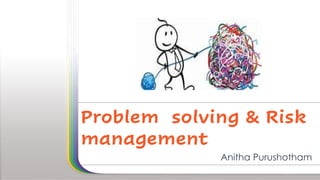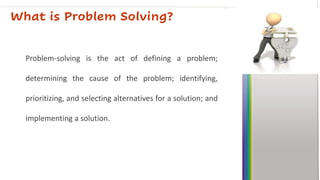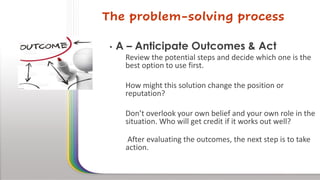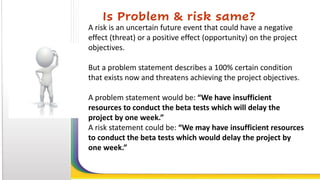Problem Solving-MIT.pptx
- 1. Problem solving & Risk management Anitha Purushotham
- 2. Agenda What is a problem?. What is problem solving? What is risk? Different Kinds of risk in business. The problem solving process Risk management
- 3. Solve this!!! CONNECT THE DOTS USING 3 LINES WITHOUT RAISING YOUR PENCIL CONNECT THE DOTS USING 4 LINES WITHOUT RAISING YOUR PENCIL.
- 4. Solution CONNECT THE DOTS USING 3 LINES WITHOUT RAISING YOUR PENCIL CONNECT THE DOTS USING 4 LINES WITHOUT RAISING YOUR PENCIL.
- 5. Problem-solving is the act of defining a problem; determining the cause of the problem; identifying, prioritizing, and selecting alternatives for a solution; and implementing a solution. What is Problem Solving?
- 7. The problem-solving process âĒ I â Identify The Problem. Identify the issue in your own words. Outline the facts and the unknowns. ï What? ï When? ï Where? ï How? ï With whom? ï Why?
- 8. The problem-solving process âĒ D â Define An Outcome. By deciding on an outlined objective first, it can speed up the process of identifying solutions. What are we trying to Achieve? Preserve? Avoid? Eliminate? This step can help clarify what needs to be addressed and for what purpose
- 9. The problem-solving process âĒ E â Explore Possible Strategies. Brainstorm possible strategies. All possible solutions should be on the table during this stage. Gather additional data Broad Objective Verifiable Relevant
- 10. The problem-solving process âĒ A â Anticipate Outcomes & Act Review the potential steps and decide which one is the best option to use first. How might this solution change the position or reputation? Donât overlook your own belief and your own role in the situation. Who will get credit if it works out well? After evaluating the outcomes, the next step is to take action.
- 11. The problem-solving process âĒ L â Look And Learn Look and learn from an attempt to solve a problem Work each problem Reprioritize if necessary Maintain focus on desired outcomes After a fair trial , change options
- 12. Problem solving
- 13. Problem solving Houston, We Have a Problem! | Baamboozle - Baamboozle | The Most Fun Classroom Games!
- 14. Is Problem & risk same? A risk is an uncertain future event that could have a negative effect (threat) or a positive effect (opportunity) on the project objectives. But a problem statement describes a 100% certain condition that exists now and threatens achieving the project objectives. A problem statement would be: âWe have insufficient resources to conduct the beta tests which will delay the project by one week.â A risk statement could be: âWe may have insufficient resources to conduct the beta tests which would delay the project by one week.â
- 15. What is risk? Any situation in the future whose outcome we donât knowâĶ Negative aspect: *It can cause loss or damage Positive aspect: *You can get more than the expectation *Your ability increases *With beforehand calculation, the chances of facing loss are very less
- 16. Different kinds of risks in business Financial Relations Market Partnership Operations
- 17. What should you do? Expect Risk Not Expect Risk Accept Risk Avoid Risk
- 18. Manage risks Think Differently Systematic Problem Solving
- 19. Risk management Risk management is the process of identifying, assessing, and prioritizing the risks to minimize, monitor, and control the probability of unfortunate events. Essentially risk management is the combination of 3 steps: risk evaluation, emission and exposure control risk monitoring.
- 20. Steps of Risk management Establish the context Identification Assessment Potential Risk Treatments Create the plan Implementation Review and evaluation of the plan
- 21. Establish the context. âĒ Planning the remainder of the process âĒ Mapping out the scope of the exercise âĒ Identity and objectives of stakeholders âĒ The basis upon which risks will be evaluated âĒ Defining a framework for the process âĒ Agenda for identification and analysis
- 22. Identification âĒ Knowledge of the organization âĒ The market in which it operates âĒ The legal, social, economic, political, and climatic environment in which it does its business âĒ Its financial strengths and weaknesses âĒ Its vulnerability to unplanned losses âĒ The manufacturing processes âĒ The management systems and business mechanism by which it operates.
- 23. Assessment âĒ Potential severity of loss and to the probability of occurrence. âĒ Making the best-educated guesses possible in order to properly prioritize the implementation of the risk management plan. âĒ Determining the rate of occurrence since statistical information is not available on all kinds of past incidents.
- 24. Potential Risk Treatments âĒ Risk Transfer âĒ Risk Avoidance âĒ Risk Retention âĒ Risk control âĒ Creation of a plan
- 25. Implementation âĒ Follow all plan methods âĒ Purchase insurance policies for the risks âĒ Avoid all risks that can be avoided without sacrificing the entityâs goals
- 26. Review and Evaluation of the plan âĒ Initial risk management plans will never be perfect âĒ Actual loss results will necessitate changes in the plan âĒ Different decisions to be made in dealing with the risks being faced
- 27. Successful Women Entrepreneurs Sheila Kochouseph Chittilapally, Managing Director, V-Star Beena Kannan CEO, Seematti Harsha Thachery, Founder and CEO Masalabox Poornima Sreelal â Founder and CEO Jobveno.com





























